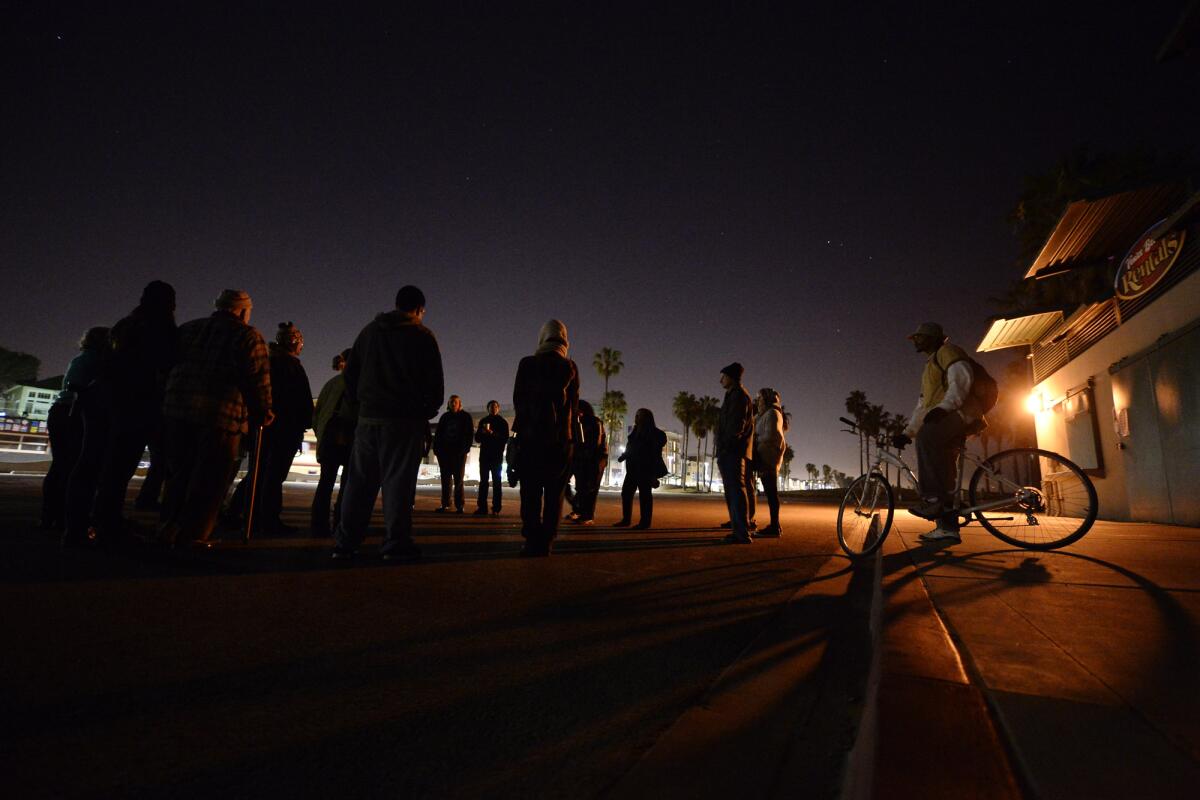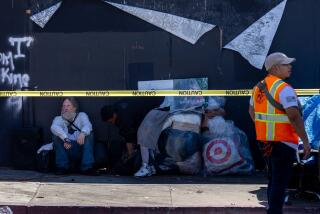Homelessness up 12% in L.A. city and county

Protesters gather last month just beyond the boardwalk in Venice Beach to challenge the city’s midnight-to-5-a.m. curfew, which they contend focuses mostly on removing homeless people. Officials plan to release an updated tally of the homeless population in L.A. County.
- Share via
The homeless population jumped 12% in the last two years in both the city and county of Los Angeles, driven by soaring rents, low wages and stubbornly high unemployment, according to a report released Monday.
In one of the most striking findings, the number of tents, makeshift encampments and vehicles occupied by homeless people soared 85%, to 9,535, according to biennial figures from the Los Angeles Homeless Services Authority.
“It’s everywhere now; the encampments are in residential neighborhoods, they’re outside of schools,” said L.A. City Councilman Mike Bonin, who represents Venice.
“It’s jarring. … It shows we’ve got a hell of a lot of work ahead.”
The rise was fueled by gentrification downtown and in Venice, where cheap hotel rooms, motels and single-room apartments — once the last refuge of the poor — are being eliminated.
Growing tensions in these rapidly changing neighborhoods were heightened by the fatal police shootings of two unarmed homeless men in just over two months. The Los Angeles Police Department is investigating the March 1 death of Charly Keunang on skid row and the killing last week in Venice of Brendon K. Glenn.
Mark Ryavec, president of the Venice Stakeholders Assn., called on Bonin, Mayor Eric Garcetti and other elected officials to “accept that fixing this situation is their responsibility, not just the LAPD’s.”
Countywide, more than 44,000 homeless people were tallied in January, up from more than 39,000 in 2013, the report said. Well over half — nearly 26,000 — were in the city of Los Angeles.
In another closely watched category, homelessness among veterans dropped 6% countywide, to about 4,400, but the report did not break out a comparable number for the city.
Garcetti and federal officials have pledged to house every homeless veteran by the end of the year, and in January the mayor said he was more than halfway to his goal.
Homeless advocates blamed public officials for the disappointing results.
“The city and county have done such a terribly poor job of creating affordable housing, basically they’ve ignored the issue,” said Steve Clare, executive director of the Venice Community Housing.
“We need shovels in the ground,” said skid row activist General Jeff Page.
Homeless authority commission members called for more state and local money, and said neighborhoods throughout the county must accept housing for homeless residents.
“There need to be enormous new dedicated resources,” said Peter Lynn, the authority’s executive director.
The rise comes at a time of renewed local focus on the problem.
After decades of squabbling and inaction, the city and county resolved old differences over homeless service tactics and began pursuing nationally recognized solutions. Those include rapidly re-housing newly homeless people and creating so-called permanent supportive housing, with mental health and addiction counseling, for the chronically homeless.
After a scathing report from City Administrative Officer Miguel A. Santana that the city spends $100 million a year on homelessness, City Council members formed a new committee in April to develop a fresh approach to ending it.
But the campaign has so far proved no match for the region’s high cost of housing and lack of new money for low-income housing or rent subsidies for the destitute, the report suggested. Despite the economic recovery after the Great Recession, the county’s unemployment rate of 7.5% still tops the national rate of 5.6%, the report said.
The tally is based on a street count conducted by 5,500 volunteers over three days in January, shelter censuses and demographic extrapolation and analysis. The number is required to receive federal funding to tackle homelessness, and is used to estimate program needs and assign resources.
Los Angeles has the nation’s largest concentration of homeless veterans. The Obama administration this year roughly doubled funding to the county, offering $105 million in homeless grants and services, according to the U.S. Department of Veteran Affairs, but the increase came largely after the January count.
Advocates say that in some cases, veterans and longtime homeless people are shoving aside those newly homeless because of the affordable housing crisis.
“What’s happened is existing resources have been re-targeted to the chronically homeless, but the pot hasn’t been significantly expanded,” Clare said.
The city’s affordable housing fund, which in 2008 totaled $108 million, plunged to $26 million in 2014.
In his proposed budget, Garcetti called for $5 million in general fund money and $5 million in yet-to-be negotiated taxes on Airbnb short-term rentals to replenish the coffers. As part of his back-to-basics agenda, the mayor proposed spending $31 million annually on sidewalk and other improvements beginning in the next budget year.
The region has wrestled for decades with how to create housing for homeless people. Under a “containment policy,” the city concentrated services and shelters, most of which are run by religious groups, on skid row.
Unlike in New York, there is no legal right to shelter, and securing the money and political backing to build supportive housing throughout the county has been a struggle.
Christine Margiotta, vice president of community impact at United Way of Greater Los Angeles, said “it’s critical we don’t lose sight of that and become disheartened. We just need to redouble our efforts ... and have a strong eye toward prevention in the future.”
Alice Callaghan, a longtime advocate for the homeless on skid row, criticized city leaders for failing to stem the loss of housing.
“All we get from City Hall is breezy poetry — ‘I will house everybody by next year.’ That’s absurd. There’s no housing to put people in,” Callaghan said. “It’s very depressing. I don’t think people understand how bad it is.”
Twitter: @geholland
Twitter: @skarlamangla
More to Read
Sign up for Essential California
The most important California stories and recommendations in your inbox every morning.
You may occasionally receive promotional content from the Los Angeles Times.















